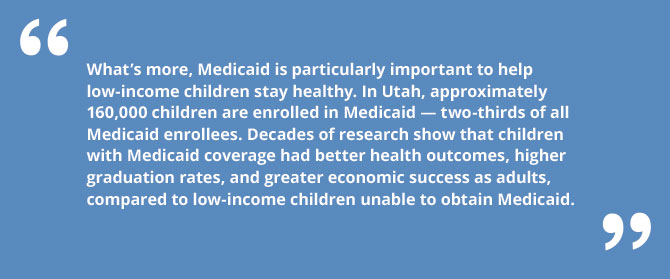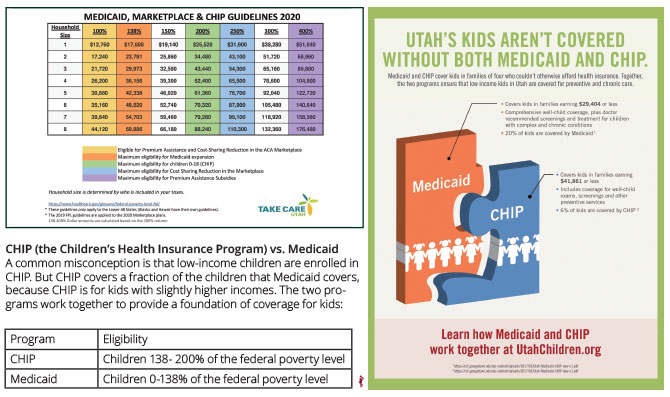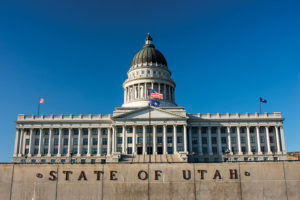By Jessie Mandle, Senior Health Policy Analyst at Voices for Utah Children
When I moved to Utah almost six years ago from the San Francisco Bay Area, many people were talking about “Medicaid Expansion.” It’s embarrassing to admit now, but I was not familiar with expansion. I was lucky enough to have insurance. California had long ago expanded its Medicaid program. What was everyone talking about?
I would soon become deeply immersed in Utah’s fight to expand Medicaid when I joined the nonprofit children’s advocacy group, Voices for Utah Children. My organization, along with many others, including the Utah Academy of Family Physicians, the Utah Health Policy Project, AARP of Utah, the Association for Utah Community Health, and others, worked together over the years to close the Medicaid coverage gap.
Utah’s fight to expand Medicaid has been long and challenging: numerous legislative efforts; a 2018 statewide ballot initiative in which Utahns voted for full expansion; the Legislature’s complicated multiphased modification to the voter-approved expansion, which left many Utahns frustrated and confused and still without coverage. Finally, on Jan. 1, 2020, Utah accepted full expansion and became the 37th state in the nation to expand Medicaid and close the coverage gap.
As we now face the dual crises of a pandemic and economic downturn, it is more important than ever to look at what Medicaid expansion means for Utahns and the actions we need to take going forward.
What was the Medicaid Coverage Gap? A Quick Refresher:
Since its inception, Medicaid has been a health insurance program for low-income children, seniors and people with disabilities. Medicaid is financed through a shared state-federal financial arrangement. The feds take on most of the cost of the program, with states providing a “match.” In Utah, the federal government pays about 70% of our Medicaid costs, while Utah puts up the other 30%. Over the years, new categories of people have become eligible for Medicaid, such as pregnant women and extremely low-income parents. But until recently, most parents and almost all low-income adults under 65 and without a disability had not qualified for Medicaid coverage.
A key piece of the Affordable Care Act was that it directed all states to expand their Medicaid program. Knowing this would be a financial challenge for states, the ACA said that states would pay no more than 10% of the cost to expand Medicaid, and the federal government would cover the remaining 90%.
But as we know, the Supreme Court did not uphold this provision of the ACA — leaving many states who chose to simply not expand.
Unfortunately, the elaborate health care marketplace the ACA set up did not account for states rejecting Medicaid expansion. The ACA health care marketplace only allowed people to enroll if they made above the federal poverty level. As a result, in states that did not expand Medicaid, many low-income Americans were left in an “insurance coverage gap,” making too much for Medicaid, but too little to enroll in the ACA marketplace. In Utah, it was estimated that anywhere from 100,000-150,000 people were in this coverage gap and unable to get health coverage.

A Look at Why Medicaid Matters for Children and Families
At Voices for Utah Children, many questioned why we were fighting for full Medicaid expansion. After all, the majority of low-income children in Utah are already guaranteed Medicaid and CHIP coverage. However, children’s advocacy groups across the nation are fighting for expansion because parents need health insurance, too. When parents are healthier or not worried about medical bills, the whole family has better outcomes. Also, when parents are covered, children are more likely to be covered too. States that expanded Medicaid saw a significant decline in the number of uninsured children.
Ensuring children is especially important here in Utah, where we have one of the highest rates of uninsured children in the nation. According to the most recent census data, Utah ranked #44 with over 72,000 uninsured children. Compared to other states in the nation, Utah also has one of the highest rates of children who are eligible for Medicaid or CHIP, but not enrolling in these programs. Medicaid expansion is one of the most effective changes states can make to not only help more adults but also ensure that more children are covered.
What’s more, Medicaid is particularly important to help low-income children stay healthy. In Utah, approximately 160,000 children are enrolled in Medicaid — two-thirds of all Medicaid enrollees. Decades of research show that children with Medicaid coverage had better health outcomes, higher graduation rates, and greater economic success as adults, compared to low-income children unable to obtain Medicaid.
At its heart, Medicaid is, in many ways, a children’s program. It guarantees all children a comprehensive set of benefits, known as the acronym EPSDT (early and periodic screenings, diagnostics and treatment). EPSDT is widely recognized as the definitive standard for children, allowing them to get preventive care and treatment before a condition escalates. Children on Medicaid can get the care they need, without restrictions or barriers.
What Lies Ahead? Additional Actions Needed
As we now face a pandemic and economic downturn, Medicaid should be an important resource for families and individuals in need. Unfortunately, many Utah families do not know about Medicaid. Across the state, we need to increase Medicaid outreach and enrollment assistance. Confusion around who is eligible for Medicaid and the stigma associated with enrolling in public assistance programs often leads many families to miss out on the health care they need. Public awareness and outreach can help change this.
In addition to helping families enroll in Medicaid, we also need to help them stay enrolled. Too often, eligible children or their parents lose Medicaid because of a minor change in income or a missed piece of paperwork. Progress was made this past Legislative Session when the Legislature funded a policy to ensure 12-month continuous eligibility for children on Medicaid. This policy helps keeps children covered and reduces gaps in their health coverage. While the Legislature only funded continuous eligibility for children through age 6, this is a critical step forward and a win for children’s health coverage. What’s more, the federal government has said that during the COVID-19 pandemic, no one enrolled in Medicaid can lose coverage (unless requested). This decision ensures that, at least for a few months, low-income families will retain their coverage.
Utah’s Governor Herbert has also made some important changes to our Medicaid program in response to the COVID-19 pandemic. Perhaps one of the most significant changes was suspending new, onerous Medicaid work reporting requirements. Utah was the only state with active Medicaid work requirements. Other states, which had initially instituted work requirements, found they created more bureaucratic red tape and program confusion, did not produce substantive increases in employment, and instead led to eligible enrollees losing their coverage. We hope the decision to suspend work requirements and other harmful barriers to care becomes permanent.
Finally, while Utah closed the Medicaid coverage gap, another gap remains. Thousands of low-income, working Utahns are still shut out of Medicaid because of their citizenship status. Thousands more are in mixed-status immigrant families and afraid to seek Medicaid. No Utahn should be afraid to get health care or denied coverage — especially now.
The COVID-19 crisis has exposed many gaps and disparities in our current health care system, but it has also highlighted the power that we can have when we work together and respond as a community, including statewide support for full expansion in the 2018 ballot initiative. As a result, thousands of additional Utahns will be covered and receive care during the pandemic and economic crisis. I believe we can build on this success work to ensure that all Utahns, no matter their background or immigration status, can receive comprehensive, affordable, accessible health care. Utah’s Medicaid expansion tale is not the end of the story — there are many chapters ahead.
- Some helpful resources for patients and providers are as follows:
Dial 2-1-1 from any phone in the state of Utah for in-person assistance on health
care enrollment. - Contact the Utah Department of Health information on how to apply for medical benefits:
https://medicaid.utah.gov/apply-medicaid/. - Use remote enrollment options from the Utah Health Policy Project:
https://bit.ly/3bopwaU. - Watch a video about Medicaid expansion that was created by the Utah Department of Health. You can find it at https://bit.ly/3dTtfz5.

By UAFP
This story appears in Issue 1 2020 of the UAFP Journal.







